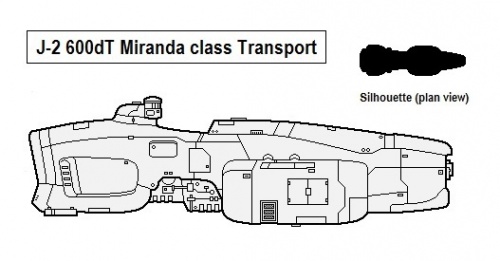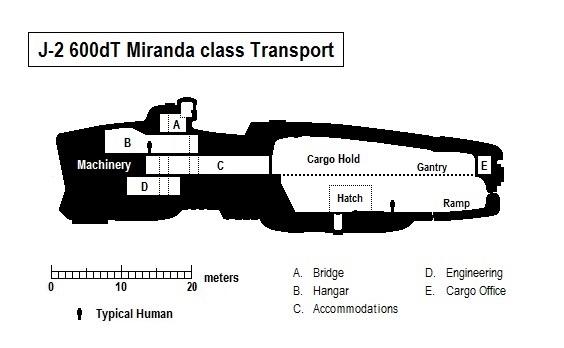Miranda class Military Transport
| Miranda class Military Transport | |
|---|---|
 Distant Fringe vessel. | |
| Type: IV Military Transport | |
| Category | ACS |
| Size | 600 Tons |
| Hull Configuration | Cone Hull |
| Streamlining | Streamlined Hull |
| Tech Level | TL–11 |
| Engineering | |
| Computer | Model/2bis |
| Jump | J-2 |
| Maneuver | 2 G |
| Armaments | |
| Hardpoints | 6 |
| Accommodations | |
| Staterooms | 0 |
| Personnel | |
| Crew | 10 |
| Officers | 2 |
| Enlisted | 8 |
| High/Mid Passengers | 0 |
| Payload | |
| Cargo | 160 Tons |
| Fuel tank | 0 Tons |
| Construction | |
| Origin | Distant Fringe |
| Year Operational | Unknown |
| End of Service | Still in active service. |
| Price | |
| Cost | MCr366.080 (base) MCr294.096 (qty) |
| Architect fee | MCrAde Stewart |
| Statistics | |
| Quick Ship Profile | T-FS22 |
| Images | |
| Blueprint | Yes. |
| Illustration | Yes |
| Source | |
| Also see | Combat Transport |
| Canon | Published, fan design |
| Era | 1105 |
| Reference | Fan: Ade Stewart |
| Starships are designed with the Classic Traveller format, using Book 5 High Guard | |
The Miranda class Military Transport is a starship.
- It is a Paramilitary Ship and a Military Transport.
- The vessel is a TL-11 design.
- Please also see AAB article: Ships of the Distant Fringe.
- Please also see AAB article: Warships of the Distant Fringe.
Description (Specifications)[edit]
The Miranda class is a military transport commonly encountered within the Distant Fringe region. It is classified as a Transport and is constructed as a conventional design. Similar designs have been in use from the time the Distant Fringe was first settled.
Image Repository[edit]
- A side view of a Miranda class Military Transport.

General Description[edit]
The Miranda class is a streamlined flattened cone with a mean diameter of 13 meters and a length of around 60 meters. Some sections are narrower and some are wider, giving it a total enclosed volume of approximately 8,100 cubic meters. The forward part of the ship is given over to the cargo hold: a gantry runs around the interior of the hold space and a small office is located in the bow. Engineering, the machinery and fuel tankage are located aft. Cabins lie centrally and the bridge is located dorsally it is divided into a long narrow "flying" bridge with projecting wings and a small armored "citadel" bridge.

A basic deck plan of the vessel indicating the general layout and positioning of major elements.
Basic Ship Characteristics[edit]
Following the Imperial Navy and IISS Universal Ship Profile and data, additional information is presented in the format shown here. The small craft factor indicates the number of squadrons (...of ten subcraft) carried on the ship. Tonnage on the universal ship profile is shown in kilotons (...thousands of tons) where necessary. [1]
| Basic Ship Characteristics [2] | ||
|---|---|---|
| No. | Category | Remarks |
| 1. | Tonnage | The Military Transport is constructed using a 600 dTon hull built in a generally cone-shaped configuration. The hull is partially streamlined, giving a reasonable atmospheric performance that is entirely reliant on its gravitic systems.
|
| 2. | Crew | Total Crew Complement: x10 (x2 Officers, x8 Enlisted)
Accommodations
There are 20 Low Berths. Accessible areas of the hull are fitted with grav plates and inertial compensators and have full life support and environmental systems.
|
| 3. | Performance | The vessel mounts a DeVoss-type Jump-2 drive, a Maneuver-2 drive and a Power Plant-2, giving performance of 2-G acceleration and producing 12 Energy Points. The ship has an agility rating of 2. The internal fuel tankage gives the power plant 4 weeks duration.
|
| 4. | Electronics | Adjacent to the bridge is a Model/2bis Computer: the vessel does not have a backup computer.
|
| 5. | Hardpoints | x6 hardpoints. |
| 6. | Armament | The normal weapons fit-out for a Military Transport is:
x2 triple Missile turrets, grouped into one battery of 2 linked turrets
|
| 7. | Defenses | The hull is plated and structurally reinforced, with an armor rating of 3.
x4 triple Sandcaster turrets, grouped into two batteries each of 2 linked turrets The vessel is not fitted with screens or other passive defensive systems. |
| 8. | Craft | Flight Section
The subcraft is housed in a dedicated hanger located aft: the hangers can be sealed and have a total volume of 10 dTons. |
| 9. | Fuel Treatment | The vessel has internal fuel tankage of 136 dTons.
|
| 10. | Cost | The basic cost of the vessel, complete with its complement of subcraft, is MCr366.080 |
| 11. | Construction Time | 96 weeks (24 months) as standard.
|
| 12. | Comments | Standard cargo capacity amounts to 160 dTons.
|
History & Background (Dossier)[edit]
The Miranda class is classified as a Combat Transport and is used to ferry AFVs, supplies, troops, and equipment into and out of potentially dangerous areas. The Miranda is broadly representative of the type and has a typical fit out of weapons systems and onboard electronics.
Class Naming Practice/s & Peculiarities[edit]
Vessel Peculiarities: No information yet available.
Class Naming Practice/s: A number of companies manufacture ships equivalent to the Miranda class. They vary in hull shape and internal layout but all share the same basic design and all have very similar capabilities and performance characteristics.
- Each variant class is named by the company that produces it, but these organizations generally draw on traditional naming protocols. It is not uncommon for a historical class name to be reused.
- Individual vessels within a class are issued specific serial numbers and transponder codes but are traditionally named by their first crew. This is considered a serious affair and a ship with a frivolous name is considered "unlucky".
Selected Variant Types & Classes[edit]
Military Ship - Military Auxiliary - Combat Vehicle Transport:
References & Contributors (Sources)[edit]
| This article has metadata. |
| This article is missing content for one or more detailed sections. Additional details are required to complete the article. You can help the Traveller Wiki by expanding it. |
- Marc Miller, Frank Chadwick, John Harshman. High Guard (Game Designers Workshop, 1980), 20-37. (Design Sequence Used)
- Traveller Wiki Editorial Team
- Author & Contributor: Lord (Marquis) and Master Scout Emeritus Adie Alegoric Stewart of the IISS
- Author & Contributor: Lord (Marquis) and Master of Sophontology Maksim-Smelchak of the Ministry of Science
- ↑ Timothy B. Brown. Fighting Ships (Game Designers Workshop, 1981), 10.
- ↑ Timothy B. Brown. Fighting Ships (Game Designers Workshop, 1981), 10.